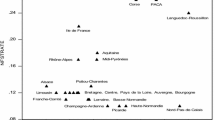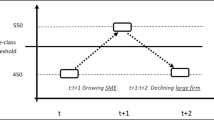Abstract
The extraordinary growth of the Irish economy since the mid-1990s—the ‘Celtic Tiger’—has attracted a great deal of interest, commentary and research. Indeed, many countries look to Ireland as an economic development role model, and it has been suggested that Ireland might provide key lessons for other EU members as they seek to achieve the objectives set out in the Lisbon Agenda. Much of the discussion of Ireland’s growth has focused on its possible triggers: the long-term consequences of the late 1980s fiscal stabilisation, EU structural funds, education, wage moderation and devaluation of the Irish punt. The industrial policy perspective has highlighted the importance of inflows of foreign direct investment, but a notable absence from the discourse on the ‘Celtic Tiger’ has been any mention of the role of new business venture creation and entrepreneurship. In this paper we use unpublished Irish VAT data for the years 1988–2004 to provide the first detailed look at national trends in business birth and death rates in Ireland over the ‘take-off’ period. We also use sub-national VAT data to shed light on spatial trends in new venture creation. Our overall conclusions are that new business formation made no detectable contribution to the acceleration of Ireland’s growth in the late 1990s, although we do find evidence of spatial convergence in per capita business stocks.






Similar content being viewed by others
Notes
For a useful summary of this literature, see Robinson et al. (2006).
Previous examinations of the role of new firm formation in national and regional economic growth in Ireland can be found in Gudgin and Hart (1994), Hart and Hanvey (1995a, b) and Gudgin et al. (1995). These studies used new firm formation data for the periods 1980–1990 and 1973–1990, respectively, and, as such, are not pertinent to the central research question of this paper. Their overall conclusion was that in the Irish economy, it was FDI that was the major component of job generation.
From the aggregate published statistics of the Department of Revenue, Government of Ireland.
The dataset was also classified by the four-digit NACE code, but initial examination of the data suggested that the NACE codes may not always have been applied in the same way. For example, the proportion of registration and deregistrations classified as ‘other’ was significantly higher in the early years compared to later years.
For example, Johnson and Conway (1997) concluded that VAT data do have the advantage that they are relatively comprehensive, are “official” and are collected on a regular basis. The OECD micro-level dataset on firm demographics uses VAT business registers in many of the industrial countries as a key input into identifying business entry and exit (see Bartelsman et al. 2004).
Detailed discussions with officials in the Revenue Commissioners responsible for the Irish VAT statistics confirm that their administrative categories broadly conform to this notion of business ‘births’ and ‘deaths’.
As we observed earlier this was the year the Irish Government announced a tax amnesty. Although it has not yet been possible to estimate how this may have affected the trend of VAT registrations and cancellations in the early years of our study period, it is reasonable to assume that some of the rise in VAT registrations in 1989 and 1990 may be related to this amnesty as businesses not previously registered for VAT took an opportunity to do so as part of a wider legitimisation of their tax affairs.
In each case a single tick mark represents 10,000 businesses.
Storey (1994, Fig. 4.1, p.83) reports a very 'flat' death rate for the UK computed from VAT figures for 1980–1991.
At an editor’s suggestion, we experimented with a different method of constructing the ‘net birth rate’ data, combining inflows over a period to yield what amounts to a ‘moving average’ rate, but this made no substantial difference to these conclusions.
Full results available on request.
The data are collected for “bailiwicks”; these are the administrative unit (or Tax District) historically used by the Revenue Commissioners with (approximately) the boundaries of Irish counties. There are 28 bailiwicks (roughly speaking), one for each county and one extra each for the cities of Dublin and Cork.
Of course, there is a degree of arbitrariness in this classification, but notice that the bailiwick closest to the upper/lower border Kerry (KERR) is a neighbour to Clare.
References
Acs, Z., Brooksbank, D., O’Gorman, C., Pickernell, D., & Terjesen, S. (2007a). The knowledge spillover theory of entrepreneurship and foreign direct investment. Jena Economic Research papers, no. 2007-059, Friedrich Schiller University Jena and Max Planck Institute of Economics, Jena Germany.
Acs, Z., O’Gorman, C., & Terjesen, S. (2007b). Could the Irish miracle be repeated in Hungary? Small Business Economics, 28(2–3), 123–142.
Andreosso-O’Callaghan, B., & Lenihan, H. (2006). Is Ireland a role model for SME development in the new EU member states? Journal of European Integration, 28(3), 277–303.
Anyadike-Danes, M., & Hart, M. (2006). The impact of sector, specialisation and space in the UKs business birth and death rates: a challenge for policy? Environment and Planning C: Government and Policy, 24(6), 815–826.
Anyadike-Danes, M., Hart, M., & O’Reilly, M. (2004). Watch that space! The county hierarchy in firm births and deaths in the UK, 1980–1999. Small Business Economics, 25(3), 273–292.
Ashcroft, B., Love, J., & Malloy, E. (1991). New firm formation in the British counties, with special reference to Scotland. Regional Studies, 25(5), 395–409.
Audretsch, D., & Thurik, R. (2001). Linking entrepreneurship to growth. OECD Science, Technology and Industry Working Papers, 2001/2, OECD, Paris.
Bailey, D., de Ruyter, A., & Kavanagh, N. (2007). Lisbon, Sapir and industrial policy: Evaluating the Irish experience. International Review of Applied Economics, 21(3), 453–467.
Barry, F. (1999). Understanding Ireland’s economic growth. Basingstoke: Macmillan Press.
Barry, F. (2002). The Celtic Tiger Era: Delayed convergence or regional boom? ESRI. Quarterly Economic Commentary, 21(Summer), 84–91.
Barry, F. (2004). Export-platform foreign direct investment: the Irish experience. European Investment Bank Papers, 9(2), 8–37.
Bartelsmann, E., Haltiwanger, J., & Scarpetta, S. (2004). Microeconomic evidence of creative destruction in industrial and developing countries. Amsterdam: Tinbergen Institute. Discussion Paper, TI 2004–114/3.
Braunerhjelm, P., Faini, R., Norman, V., Ruane, F., & Seabright, P. (2000). Integration and the regions of Europe: How the right policies can prevent polarisation. Monitoring European Integration 10. London: Centre for Economic Policy Research.
Buckley, R., Leddin, A., & Lenihan, H. (2006). An assessment of the contribution of MNEs to the Irish Economy. Presentation to I11 Foro De Economia Regional FPRP Economico De La Rioja, Spain, 9–11 May.
Burnham, J. (2003). The Celtic Tiger. Wilson Quarterly, 27(3), 110–111.
Cassidy, M. (2004). Productivity in Ireland: trends and issues. Central Bank and Financial Services Authority of Ireland Quarterly Bulletin, Spring, 83–105.
Department of Finance. (1958). First programme for economic expansion. Report, Department of Finance, Government of Ireland, Dublin.
Ferreira, M., & Vanhoudt, P. (2004). Catching the Celtic Tiger by its tail. European Journal of Education, 39(2), 209–234.
Foley, A., & McAleese, D. (1991). Overseas industry in Ireland. Dublin: Gill and Macmillan.
Fritsch, M., & Mueller, P. (2004). Effects of new business formation on regional development over time. Regional Studies, 38(8), 961–976.
Görg, H., & Strobl, E. (2002). Multinational companies and indigenous development: An empirical analysis. European Economic Review, 46(7), 1305–1322.
Görg, H., & Strobl, E. (2003). Multinational companies, technology spillovers and plant survival. Scandinavian Journal of Economics, 105(4), 581–595.
Gray, A. (Ed.). (1997). International perspectives on the Irish economy. Dublin: Indecon Economic Consultants.
Gudgin, G., & Hart, M. (1994). Spatial variations in new firm formation in the Republic of Ireland, 1980–90. Regional Studies, 28(4), 363–376.
Gudgin, G., Scott, R., Hanvey, E., & Hart, M. (1995). The role of small firms in employment growth in Ireland, north and south. In J. Bradley (Ed.), The two economies of Ireland: Public policy, growth and employment. Dublin: Oak Tree Press.
Harris, W. (2005). Secrets of the Celtic Tiger. Issues in Science and Technology, 21(4), 23–27.
Harrison, R. T., & Hart, M. (1983). Factors influencing new-business formation: A case study of Northern Ireland. Environment and Planning A, 15, 1395–1412.
Hart, M., & Hanvey, E. (1995a). New firm formation and the job generation debate: Some evidence from the late 1980s. Small Business Economics, 7(2), 97–108.
Hart, M., & Hanvey, E. (1995b). The role of small firms in employment growth in Ireland, north and south. In A. Burke (Ed.), Enterprise and the Irish economy. Dublin: Oak Tree Press.
Honohan, P., & Walsh, B. (2002). Catching up with the leaders: The irish hare. Brookings Papers on Economic Activity, 2002(1), 1–57.
Johnson, P., & Conway, C. (1997). How good are the UK VAT registration data at measuring firm births? Small Business Economics, 9(5), 403–409.
Koellinger, P. D., & Thurik, R. (2009). Entrepreneurship and the Business Cycle. Amsterdam: Tinbergen Institute. Discussion Paper, TI 2009-032/3.
Love, J. (1995). The measurement of entry rates: Reconsideration and resolution. Empirica, 22(2), 151–157.
McAleese, D. (2000). The Celtic Tiger: Origins and prospects. Policy Options, 21, 46–50.
Plummer, L., & Acs, Z. (2005). Penetrating the knowledge filter in regional economies. The Annals of Regional Science, 39(3), 439–456.
Robinson, C., OLeary, B., & Rincon, A. (2006). Business start-ups, closures and economic churn: a review of the literature. Report, Enterprise Directorate, London: Department for Business, Enterprise and Regulatory Reform.
Sapir, A., Aghion, P., Bertola, G., Hellwwig, M., Pisani-Ferry, J., Rosati, D., et al. (2003). An agenda for growing Europe—making the EU economic system deliver. Brussels: European Commission.
Slaughter, M. (2003). Host-country determinants of U.S. foreign direct investment into Europe. In H. Herrmann & R. Lipsey (Eds.), Foreign direct investment in the real and financial Sector of industrial economies (pp. 7–32). Berlin: Springer.
Storey, D. (1994). Understanding the small business sector. London: Routledge.
Strobl, E., Walsh, P., & Barry, F. (1998). Aggregate job creation, job destruction and job turnover in the Irish manufacturing sector. The Economic and Social Review, 29(1), 55–71.
Thurik, R., & Wennekers, S. (2004). Entrepreneurship, small business and economic growth. Journal of Small Business and Enterprise Development, 11(1), 140–149.
van Stel, A., Carree, M., & Thurik, R. (2005). The effect of entrepreneurial activity on national economic growth. Small Business Economics, 24(3), 311–321.
van Stel, A., & Storey, D. (2004). The link between firm births and employment: Is there an upas tree effect? Regional Studies, 38(8), 893–909.
Wennekers, S., & Thurik, R. (1999). Linking entrepreneurship and economic growth. Small Business Economics, 13(1), 27–55.
Wennekers, S., van Stel, A., Thurik, R., & Reynolds, P. (1999). Nascent entrepreneurship and local economic development. Small Business Economics, 24(3), 293–309.
Acknowledgement
Thanks to the Irish Revenue Commissioners for access to the unpublished VAT data as well as comments from audiences at conferences and seminars in Limerick (EUNIP), Paris (ERSA) and the Centre for Business Research at Judge Business School (University of Cambridge) where Helena Lenihan was on sabbatical for part of 2008. The usual disclaimer applies.
Author information
Authors and Affiliations
Corresponding author
Rights and permissions
About this article
Cite this article
Anyadike-Danes, M., Hart, M. & Lenihan, H. New business formation in a rapidly growing economy: the Irish experience. Small Bus Econ 36, 503–516 (2011). https://doi.org/10.1007/s11187-009-9251-1
Accepted:
Published:
Issue Date:
DOI: https://doi.org/10.1007/s11187-009-9251-1




